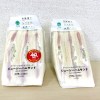Among the many storylines to keep an eye on in the run-up to the 2020 Tokyo Olympics are advancements in the equipment the competitors will be using. As science and technology march on, Olympic athletes have access to sleeker, lighter, thinner gear, allowing them to reach levels of performance above and beyond those of their predecessors.
We’ve seen this happen on the track and in the pool, but it’ll also be happening in the bedrooms of the Olympic Village, likely with the help of Olympic condoms from Japanese manufacturer Sagami Rubber.
Since the 1988 Summer Olympics in Seoul, condoms have been distributed to Olympic athletes. This endorsement of bedroom diplomacy may seem like a base perversion of the spirit of the Games, but realistically, what else would you expect to happen with a massive group of healthy, fit, young people away from home and living in close proximity to one another for a few weeks?
At the 2012 London Games, 150,000 condoms, the largest quantity ever, were prepared for the 10,500 competitors. Shortages began occurring in just five days, illustrating either impressively frequent mattress athletics or an astounding number of balloon animal parties.
Prophylactics were also distributed at the 1998 Winter Olympics in Nagano, with some being manufactured by Sagami Rubber, headquartered in Kanagawa Prefecture. Sagami Rubber’s polyurethane condoms were a hit with athletes because of their thinness, and the stock of 20,000 was quickly used up.
Although the official suppliers for the upcoming Tokyo Games have yet to be selected, Sagami Rubber is hoping to once again receive the honor. “We hope to be able to recreate the reaction our products had at Nagaano,” said Sagami Rubber representative Hiroshi Toisawa. “Condom manufacturing is a specialty of Japan, and the Tokyo Olympics will be a great opportunity to show what we can do.”
Sagami Rubber’s current flagship condom, the Sagami Original, has a remarkable thinness of 0.024 millimeters. “Before the Tokyo Olympics, we’re going to get that down below 0.020,” promises Toisawa.
Producing such a thin condom is a high hurdle, though. Sagami Rubber’s offerings first got under 0.030 millimeters in 2005, when the company succeeded in making a condom with a thickness of 0.028 millimeters. The current 0.024-millimeter Sagami Orgiginal was released in 2011, meaning that six years were required for just four microns of progress. With seven years until the Tokyo Olympics, Sagami Rubber can’t afford to dawdle.
Truth be told, the Sagami Original isn’t the company’s thinnest product. That distinction goes to the top-of-the-line 0.022-millimeter Sagami Original Premium, certified as the world’s thinnest condom. However, the Premium also commands a single unit price of 500 yen (US$5), compared to 175 yen for a standard Sagami Original.
However, Sagami Rubber is not the only manufacturer looking to outfit every man’s most-prized body part, world-class athlete or not. Like so many other memorable Olympic moments made possible by two rivals at the top of their game pushing each other to succeed, Tokyo-based condom producer Okamoto isn’t going to let Sagami Rubber take the podium without a fight. Also a supplier at the Nagano Olympics, Okamoto lays claim to the world’s thinnest latex condom at 0.03 millimeters.
Okamoto feels there’s more to making a good condom than just thinness. “Polyurethane has the drawback of being a little harder than latex, which we use” explained a spokesman for the company. “Also, the design of condoms tends to make them slightly thicker at the tip, but with our advanced production techniques, we’re hoping to achieve a uniform thinness.”
Sagami Rubber isn’t backing down from this challenge, and remains committed to using polyurethane. Toisawa understands that in simultaneously pursuing the seemingly conflicting goals of low-cost, thinness, and, of course, strength, his company has set a difficult target for itself. Like a true competitor, however, he’s keeping his eyes on the prize.
“With a condom thinner than 0.020 millimeters, it will hardly feel like you’re wearing one at all. This is going to be a revolution.”
▼ Count us in
Source: Sponichi

 Japanese condom maker pierces previous boundary with 0.01-millimeter wonder
Japanese condom maker pierces previous boundary with 0.01-millimeter wonder Ramen restaurant’s English menu prices are nearly double its Japanese ones, denies discriminating
Ramen restaurant’s English menu prices are nearly double its Japanese ones, denies discriminating Top Japanese cosplayer Enako returns to Comiket after 6 years, creates mayhem with admirers
Top Japanese cosplayer Enako returns to Comiket after 6 years, creates mayhem with admirers Rakuten randomly offers 58 New Year’s osechi feasts in Japan, but did we get a star or a dud?
Rakuten randomly offers 58 New Year’s osechi feasts in Japan, but did we get a star or a dud? What makes a good boss in Japan? Workers sound off in survey
What makes a good boss in Japan? Workers sound off in survey The Purple Lucky Bag from Village Vanguard is an extra-large waste of money
The Purple Lucky Bag from Village Vanguard is an extra-large waste of money 25 different Japanese convenience store sandwiches – What’s inside them?【Photos】
25 different Japanese convenience store sandwiches – What’s inside them?【Photos】 7 great places to see Mt. Fuji from without having to climb it
7 great places to see Mt. Fuji from without having to climb it Japanese convenience store fools us with its 40-percent-more sandwich, but in a good way
Japanese convenience store fools us with its 40-percent-more sandwich, but in a good way We made pan-fried and baked mini apple pies using gyoza dumpling wrappers【SoraKitchen】
We made pan-fried and baked mini apple pies using gyoza dumpling wrappers【SoraKitchen】 Nearly one in ten young adults living in Japan isn’t ethnically Japanese, statistics show
Nearly one in ten young adults living in Japan isn’t ethnically Japanese, statistics show Starbucks Japan ready to get Year of the Horse started with adorable drinkware and plushies【Pics】
Starbucks Japan ready to get Year of the Horse started with adorable drinkware and plushies【Pics】 Japanese beef bowl chain Sukiya’s 2026 Smile Box lucky bag basically pays for itself
Japanese beef bowl chain Sukiya’s 2026 Smile Box lucky bag basically pays for itself Hayao Miyazaki says Happy New Year to Studio Ghibli fans with new art for Year of the Horse
Hayao Miyazaki says Happy New Year to Studio Ghibli fans with new art for Year of the Horse Cup Noodle tries an authentic Jiro-style ramen, but something’s not quite right
Cup Noodle tries an authentic Jiro-style ramen, but something’s not quite right The best Starbucks Japan Frappuccinos we want to drink again in 2026
The best Starbucks Japan Frappuccinos we want to drink again in 2026 We revisited Sweets Paradise after a decade to see if Japan’s dessert buffet still delivers
We revisited Sweets Paradise after a decade to see if Japan’s dessert buffet still delivers That time Seiji called JASRAC to ask why he didn’t get paid royalties for his song being on TV
That time Seiji called JASRAC to ask why he didn’t get paid royalties for his song being on TV We found possibly the quietest Japanese-style hotel in Tokyo’s bustling Shinjuku district
We found possibly the quietest Japanese-style hotel in Tokyo’s bustling Shinjuku district Pizza Hut Japan’s hot lucky bags are perfect for a New Year’s pizza party
Pizza Hut Japan’s hot lucky bags are perfect for a New Year’s pizza party Japan’s oldest largetooth sawfish in captivity back on display in Mie Prefecture
Japan’s oldest largetooth sawfish in captivity back on display in Mie Prefecture 7-Eleven Japan starts new temporary luggage storage service in over 300 branches
7-Eleven Japan starts new temporary luggage storage service in over 300 branches Disillusionment at Tsukiji’s tourist-target prices led us to a great ramen restaurant in Tokyo
Disillusionment at Tsukiji’s tourist-target prices led us to a great ramen restaurant in Tokyo Starbucks teams up with 166-year-old Kyoto doll maker for Year of the Horse decorations【Photos】
Starbucks teams up with 166-year-old Kyoto doll maker for Year of the Horse decorations【Photos】 Tokyo considering law requiring more trash cans following litter increase in heavily touristed area
Tokyo considering law requiring more trash cans following litter increase in heavily touristed area Tokyo’s Tsukiji sushi neighborhood asks tour groups to stay away for the rest of the month
Tokyo’s Tsukiji sushi neighborhood asks tour groups to stay away for the rest of the month Tokyo event lets you travel back in time, for free, to celebrate 100 years since Showa era start
Tokyo event lets you travel back in time, for free, to celebrate 100 years since Showa era start Japan may add Japanese language proficiency, lifestyle classes to permanent foreign resident requirements
Japan may add Japanese language proficiency, lifestyle classes to permanent foreign resident requirements Sanrio theme park in Japan announces plans to expand into a Sanrio resort
Sanrio theme park in Japan announces plans to expand into a Sanrio resort Stamina-destroying “Paralysis Noodles” are Tokyo’s newest over-the-top ramen innovation
Stamina-destroying “Paralysis Noodles” are Tokyo’s newest over-the-top ramen innovation Survey asks foreign tourists what bothered them in Japan, more than half gave same answer
Survey asks foreign tourists what bothered them in Japan, more than half gave same answer Japan’s human washing machines will go on sale to general public, demos to be held in Tokyo
Japan’s human washing machines will go on sale to general public, demos to be held in Tokyo Japan’s deadliest food claims more victims, but why do people keep eating it for New Year’s?
Japan’s deadliest food claims more victims, but why do people keep eating it for New Year’s? We deeply regret going into this tunnel on our walk in the mountains of Japan
We deeply regret going into this tunnel on our walk in the mountains of Japan Studio Ghibli releases Kodama forest spirits from Princess Mononoke to light up your home
Studio Ghibli releases Kodama forest spirits from Princess Mononoke to light up your home Major Japanese hotel chain says reservations via overseas booking sites may not be valid
Major Japanese hotel chain says reservations via overseas booking sites may not be valid Put sesame oil in your coffee? Japanese maker says it’s the best way to start your day【Taste test】
Put sesame oil in your coffee? Japanese maker says it’s the best way to start your day【Taste test】 No more using real katana for tourism activities, Japan’s National Police Agency says
No more using real katana for tourism activities, Japan’s National Police Agency says Starbucks Japan reveals new sakura drinkware collection, inspired by evening cherry blossoms
Starbucks Japan reveals new sakura drinkware collection, inspired by evening cherry blossoms Updated cherry blossom forecast shows extra-long sakura season for Japan this year
Updated cherry blossom forecast shows extra-long sakura season for Japan this year
Leave a Reply